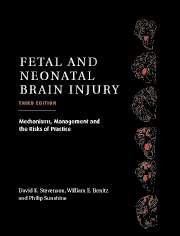Book contents
- Frontmatter
- Contents
- List of contributors
- Foreword
- Preface
- Part I Epidemiology, Pathophysiology, and Pathogenesis of Fetal and Neonatal Brain Injury
- Part II Pregnancy, Labor, and Delivery Complications Causing Brain Injury
- Part III Diagnosis of the Infant with Asphyxia
- Part IV Specific Conditions Associated with Fetal and Neonatal Brain Injury
- Part V Management of the Depressed or Neurologically Dysfunctional Neonate
- 34 Neonatal resuscitation: immediate management
- 35 Extended management
- 36 Neuroprotective mechanisms after hypoxic–ischemic injury
- 37 Neonatal seizures: an expression of fetal or neonatal brain disorders
- 38 Improving performance, reducing error, and minimizing risk in the delivery room
- 39 Nutritional support of the asphyxiated infant
- Part VI Assessing the Outcome of the Asphyxiated Infant
- Index
- Plate section
36 - Neuroprotective mechanisms after hypoxic–ischemic injury
from Part V - Management of the Depressed or Neurologically Dysfunctional Neonate
Published online by Cambridge University Press: 10 November 2010
- Frontmatter
- Contents
- List of contributors
- Foreword
- Preface
- Part I Epidemiology, Pathophysiology, and Pathogenesis of Fetal and Neonatal Brain Injury
- Part II Pregnancy, Labor, and Delivery Complications Causing Brain Injury
- Part III Diagnosis of the Infant with Asphyxia
- Part IV Specific Conditions Associated with Fetal and Neonatal Brain Injury
- Part V Management of the Depressed or Neurologically Dysfunctional Neonate
- 34 Neonatal resuscitation: immediate management
- 35 Extended management
- 36 Neuroprotective mechanisms after hypoxic–ischemic injury
- 37 Neonatal seizures: an expression of fetal or neonatal brain disorders
- 38 Improving performance, reducing error, and minimizing risk in the delivery room
- 39 Nutritional support of the asphyxiated infant
- Part VI Assessing the Outcome of the Asphyxiated Infant
- Index
- Plate section
Summary
Introduction
As discussed in Chapter 4, exposure to acutely compromised gas exchange is very common, and yet only a small minority of newborns develop evidence of hypoxic–ischemic encephalopathy (HIE). Indeed, even severe metabolic acidosis at birth is associated with HIE in less than half of cases. Similarly, experimental studies typically report that cerebral injury occurs only in a very narrow temporal window between survival with complete recovery and death. Partly this is a reflection of the efficiency of the fetal adaptations that maintain perfusion to the essential organs. In addition, an acute event activates protective endogenous cellular responses, many mediated by glia, that help limit neural injury. These processes may be modified, raising the possibility of treating acute encephalopathy.
Biphasic cell death after hypoxic–ischemic injury
The seminal observation derived from both experimental studies in vivo and in vitro and clinical observations has been that HIE is not a single event but is rather an evolving process. Although neurons may die during the actual ischemic or asphyxial event (primary cell death), many neurons initially recover at least partially from the primary insult, only to die hours or even days later (secondary or delayed cell death). Using magnetic resonance spectroscopy, Azzopardi and coworkers showed that infants with evidence of moderate-to-severe asphyxia often have normal cerebral oxidative metabolism shortly after birth, but many then go on to develop delayed energy failure 6–15h later. This phenomenon is associated with a severe mortality.
- Type
- Chapter
- Information
- Fetal and Neonatal Brain InjuryMechanisms, Management and the Risks of Practice, pp. 715 - 734Publisher: Cambridge University PressPrint publication year: 2003



